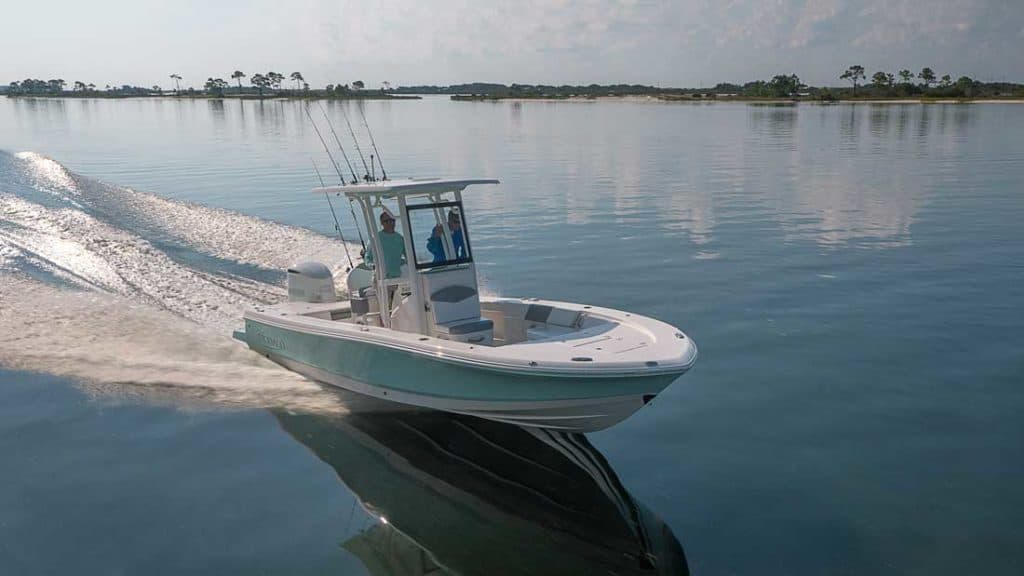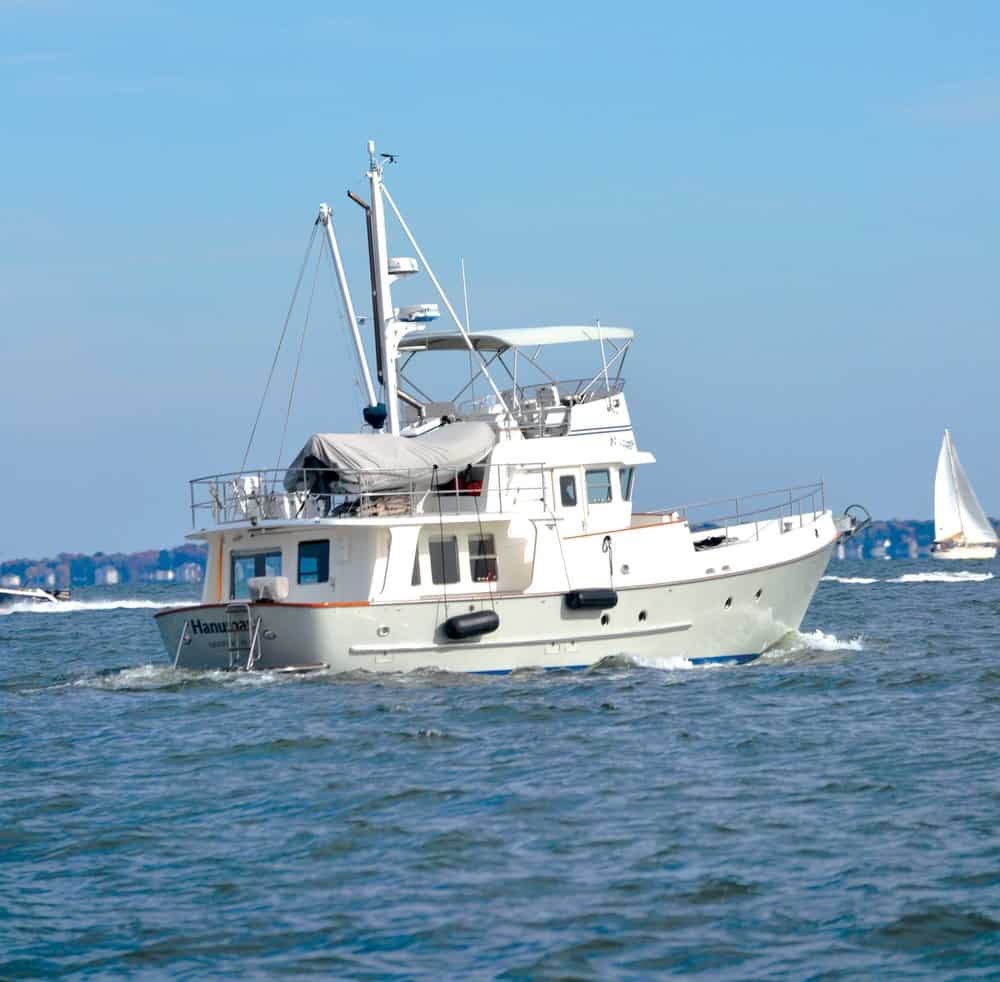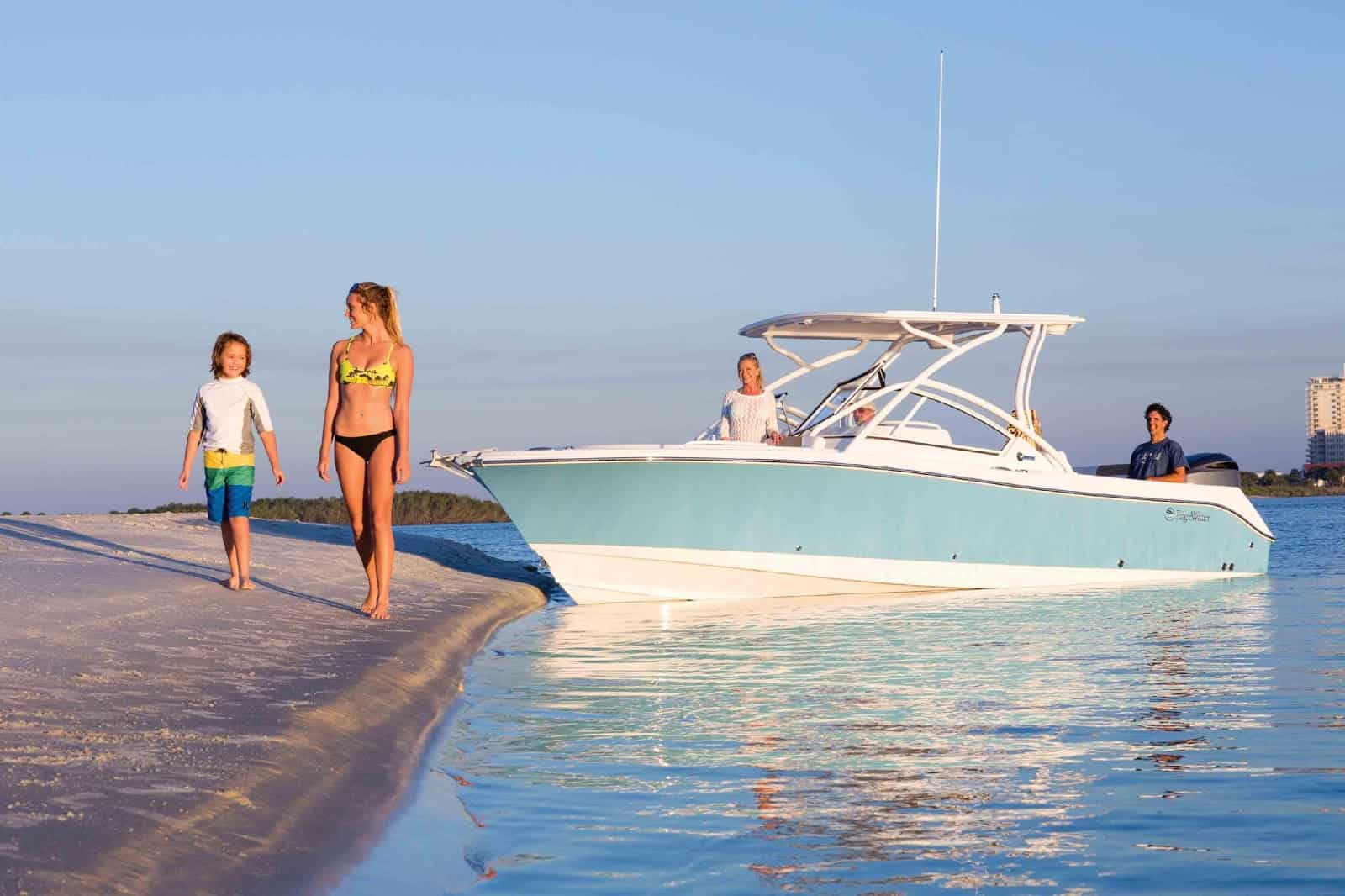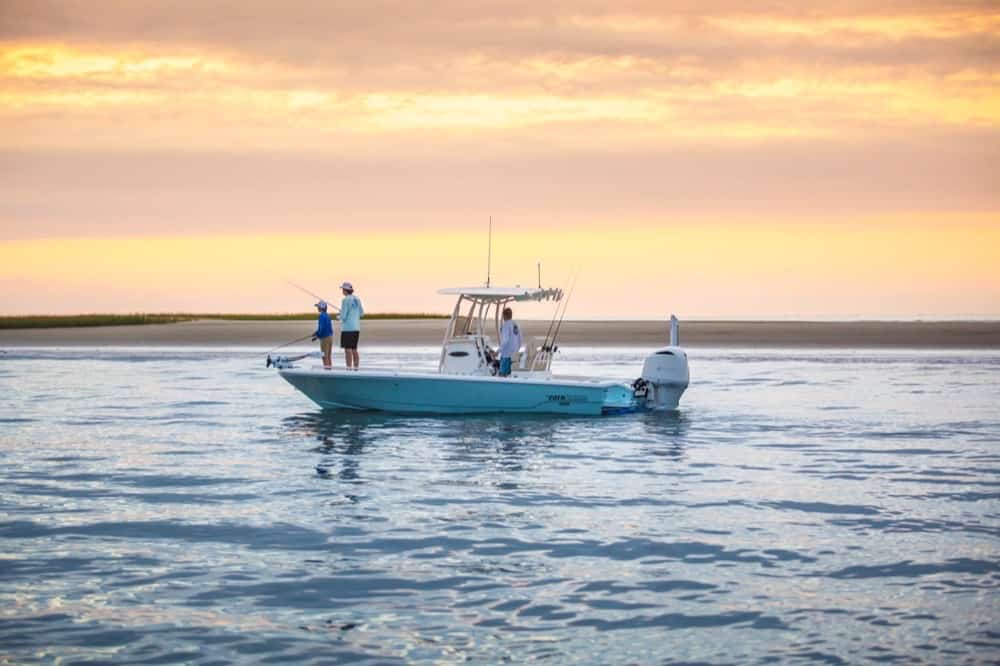
Robalo 246 Cayman
LOA: 24′ 6″
Beam: 9′
Deadrise: 16°
Draft: 12″ (engines up)
Max HP: 350
Fuel Capacity: 90 gal.
Dry Weight: 4,200 lbs.
The Robalo brand has been associated with big-water fishing since its original 19-foot center console skiff debuted in 1968. Since 2001, the brand has belonged to Marine Products Corporation of Nashville, Georgia. They’re a large boatbuilder with a reputation for strong design, engineering, production, and quality control, who also build Chaparral runabouts and tow sport boats. One mark of Marine Products quality is its sturdy upholstery, with thick vinyl material, high-density foam, and triple stitching. Another is precision lamination. Watch a video of this month’s On Boats subject, the Robalo 246 Cayman crossover center console, while it’s running at speed; you’ll note how precisely the chines and lifting strakes cut off spray and throw it out flat to the side. That kind of meticulous construction ensures that the hull performs the way its design team intended.

Robalo refers to the Cayman series (206, 226, and 246) as Bay Boats. The two smaller boats are oriented more to inshore saltwater fishing, though all three will serve families well for exploring rivers and creeks, picnicking, beachcombing, and general tow sports. With Robalo’s proprietary V-Plane running bottoms (like a 16° transom deadrise on the 246), they float shallow but their self-bailing cockpits and flared-bow buoyancy make them capable sea boats in the open waters of the Chesapeake. The 246, however, with its generous 9′ beam, offers the space for an active family (or two, since it is NMMA-certified for nine passengers) to spend a long afternoon aboard after a morning’s fishing trip. This versatility qualifies the 246 Cayman as a crossover in today’s market.
Standard power for the 246 Cayman is a single 4.2-liter Yamaha F250 outboard. Our test boat ran an optional F300, a well-proven engine that is a natural fit for a rig designed to carry people, gear, ice, food, and drink, and to do some general towing. The 300 can push the 246 over 40 knots, but the V-Plane extensions at the transom on either side of the engine lift the hull easily to plane at lower speeds. Thus, it runs very efficiently at 18–25 knots, burning 6 to 9 gallons of fuel per hour for a conservative range of more than 250 miles (using 90 percent of the fuel tank’s capacity). While the 246 is reasonably efficient at higher speeds, that lower range can still cover a lot of water while providing easy motion when seas kick up if the skipper employs the (optional) trim tabs and hydraulic jackplate to good advantage.
Along with the F300, our test boat came with Yamaha’s second-generation Helm Master EX single-engine control system. Unlike the first generation of HelmMaster, the EX system can be ordered with the boat or added in stages by a local Yamaha dealer with a technician who has trained on it. The stages include fully electric power steering, an autopilot with heading sensor, a joystick control, and several automated features for controlling drift patterns and trolling speeds (including modes slow enough to fine-tune the action of spoons and surgical hoses). We got to play with the EX system a bit and were especially impressed with two aspects: precise slow-speed maneuvering with the joystick and neat installation. EX relies on a single control cable, greatly reducing rigging complexity in the conduit from console to the utility compartment at the transom, freeing up space there for additional storage.
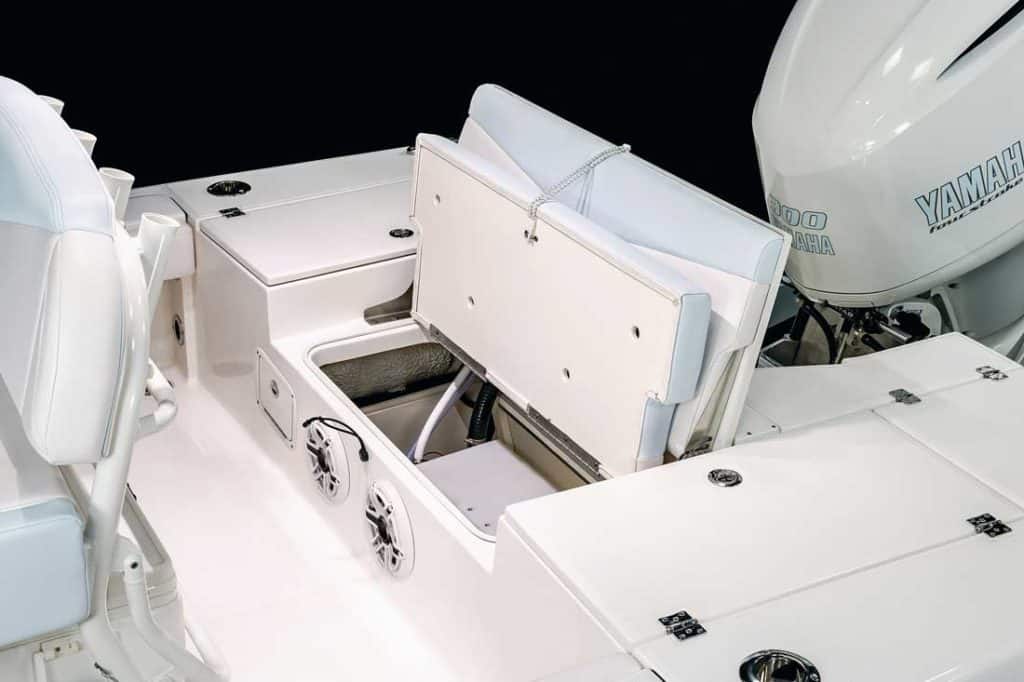
On deck, the 246 offers large bow and stern casting platforms with precisely laminated and fitted hatches for storage beneath. They include dedicated anchor/chain/rode space, three livewells (which can serve as release wells for larger fish or as coolers, too), lockable rod storage, and a large central utility compartment astern for wiring and plumbing. Additional rod storage is generous, including two horizontal racks under each gunwale and vertical holders in the aft edge of the hardtop, at the back of the helm’s leaning post, and in the gunwales.
So what kind of Chesapeake fishing would the 246 Cayman fit? Just about all of it. It’s large and able enough to handle anything the Bay could throw at a prudent skipper who avoids an excessively sporty day. With a bow-mount, 36-volt Minn Kota Riptide electric motor, it could handle a wide range of shallow water assignments, like bass and rockfish on the Susquehanna Flats or the Potomac near Washington. Ditto rockfish, speckled trout, and puppy drum from Tangier Sound to the Rappahannock, Mobjack Bay, Poquoson Flats, and the Lynnhaven River. The Riptide would also serve well for jigging and casting to fish breaking on bait anywhere from the mouth of the Chester River down past the mouth of the Potomac to the Chesapeake Bay Bridge-Tunnel. It would serve well for any fish around the lower Bay bridge-tunnels, from sheepshead to spadefish, and the Helm Master’s Pattern Shift speed control would allow precise trolling on tunnel tubes for large flounder. Spring for the 247 Cayman HD with an upper steering station, making it a “tower boat”, and it becomes a cobia-spotting machine.
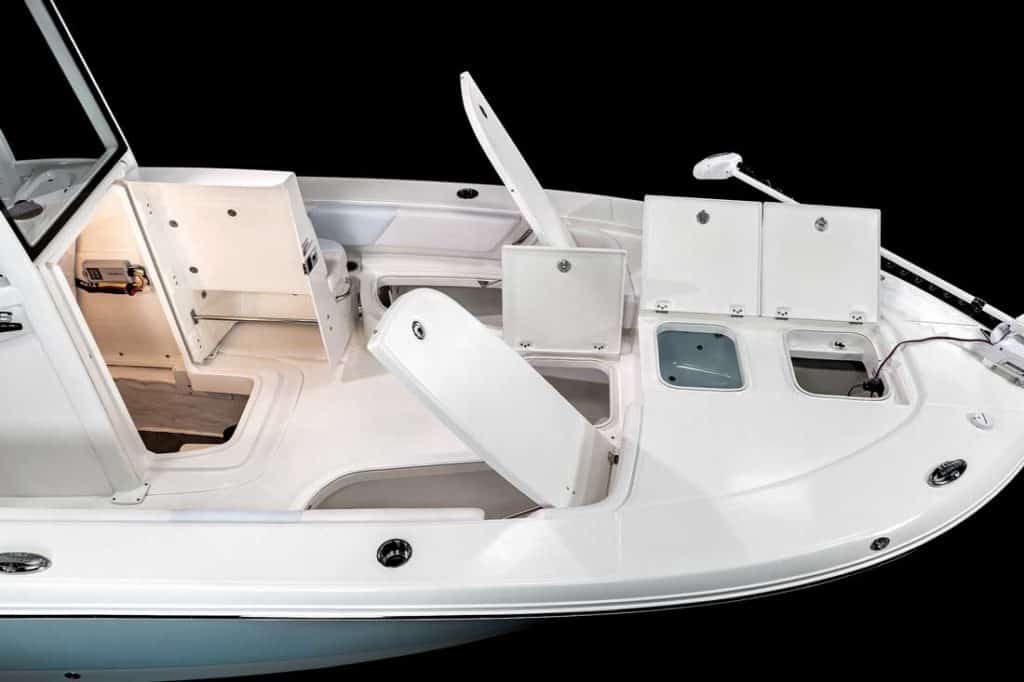
But stow the rods ashore and add cushions for playtime. The bow platform, recessed several inches below the gunwales, converts to a sunpad or a pair of forward-facing lounges, while a table is available to fit a receptacle on its after edge. The lounges, table, and the seat on the front of the console makes a comfortable setup for three to eat and drink. The console swings open for access to a large compartment for storage and a portable toilet, with plenty of sitting headroom for adults (assuming they don’t play in the NBA). Robalo’s engineering team takes the ergonomics of head compartments seriously, and the front-opening door makes it easy to back in or climb out, holding the lip of the doorway. Astern, there’s a comfortable seat for two with a back that folds up atop the utility compartment, flanked by livewells.
Like the head, the helm reflects careful thinking about ergonomics. There’s plenty of space for a large, flush-mounted electronic display, a VHF radio, switch panels, and electronic engine displays like the one needed for the Helm Master. Add in a pair of cup holders, a grab handle for the passenger to port of the skipper, and plenty of places to hold onto the hardtop frame. A pair of secure trays with cushioned, non-skid surfaces and power plugs top the console, flanking the compass (though charging a phone there is probably not a good idea while navigating by that compass). The double helm seat has up-or-down bolsters, with a grab rail and rod holders on the back side, plus secure space for a food-and-drink cooler beneath.
Robalo’s Reel Deal price on a 246 Cayman with a full suite of both fishing and family options will run about $100,000, or about $115,000 for an SD model with an upper helm. You can work out the specifics on the Boat Builder program for those models at robalo.com. That’s an attractive price compared to other high-quality crossovers. Adding the complete Yamaha Helm Master EX system will cost approximately $14,000, depending on whether the buyer specifies it from the boatbuilder or has it installed in stages by a dealer.

